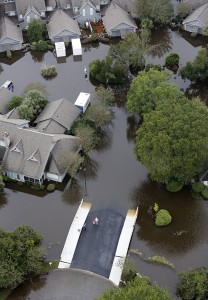Historic Flooding in South Carolina
October 6, 2015

On October 5, people stand on the safety of a bridge as homes sit in floodwater in Charleston, South Carolina. Credit: © Mic Smith, AP Photo
Since Thursday, October 1, a low pressure system combined with storms related to Hurricane Joaquin have drenched South Carolina in record heavy rains. Between Friday and Sunday, 20 inches (50 centimeters) of rain fell in Columbia, the state capital and hardest-hit city. Fourteen people have died in the flooding, mostly by drowning, many by being trapped in cars in flash floods. Hundreds of people have had to be rescued from their homes. Authorities, however, are advising people not immediately threatened by rising waters to stay home and avoid flooded roads.
South Carolina Governor Nikki Haley called the record rainfall a 1,000-year storm. (Meteorologists use this term to mean a weather event that has a 1-in-1,000 statistical chance of happening in any given year.) Governor Haley and U.S. President Barack Obama (respectively) declared the region to be a state and federal disaster area.
The rains stopped this morning, but the risk of flooding is not yet reduced, as the waters continue to rise. Since Saturday, nearly 20 dams in the flooded region have been breached (water has flowed over the top of the dam) or have failed. These failures sent huge amounts of floodwater crashing down on areas surrounding lakes and rivers. Also, because the flooding has occurred in the central part of the state, the water must move to the coast to truly relieve the flooding in the midlands.
Other World Book articles


